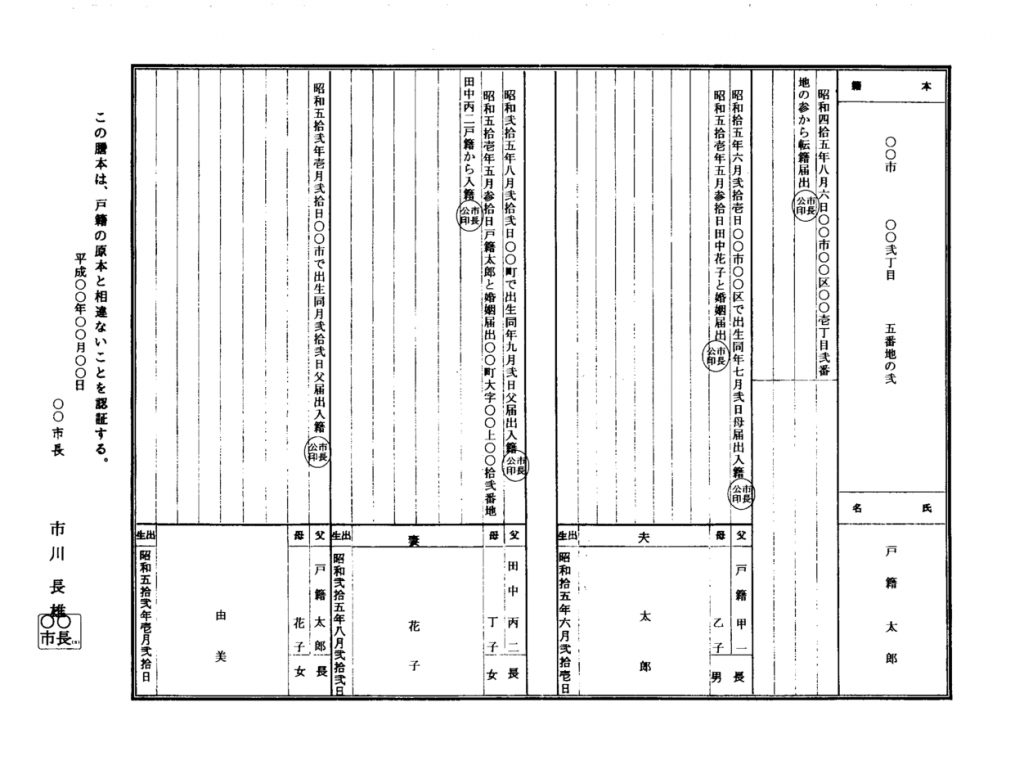A Koseki (戸籍) is an official Japanese family register, kept by the local city office. It records many of the family events, such as births, deaths, marriages, divorces, and so on, that take place in a given family. It also may list the locations where some of those events took place.
In Japan, unlike the US and some other countries, there are NO official birth certificates, marriage certificates, death certificates, and so on. All this information is listed on the Koseki document instead.
There is also a Johon document as well. It is a corollary to the Koseki. The purpose of the Johon is to record information when someone was removed from the associated Koseki. This might happen because of a death or a divorce, for example. The Johon can thus be a very valuable source of family history information.
All Japanese citizens are required to report all family events to the local city or townhall where they have their permanent domicile.
Koseki records are the perfect family tree documents. However, getting a copy of the record is not always easy. Japan has very strong privacy rules and there are strict limits as to who can obtain a copy of the Koseki information.
In order to get a copy of a Koseki, you must either be listed on the Koseki yourself, or you must be able to document that you are a direct descendent of someone who is listed on the Koseki.
The first step in obtaining a copy of a Koseki is to determine where your ancestor lived. This is often the most difficult step. MyKoseki.com was created to help with the problem of identifying the permanent domicile (the “honseki”) of your ancestor.
Unfortunately, the Koseki record will only be available at the local city office or townhall where your ancestor lived. (Frustratingly, some people used the town where they were born, while other people used the town where they were living at the time. It is very complicated…). There is no publicly accessible database that can be searched to locate the proper “honseki”. If you cannot determine where your ancestor lived, you cannot move forward.
One important thing to understand about doing family history research in Japan is that until after 1868 (the beginning of the Meiji era), only the elite nobility had family names. The common person only had a first name.
For the roughly 250 years prior to the Meiji era, Japan had been totally cut off from the rest of the world. No one was allowed to leave and no one was allowed to enter the country.
When Japan re-opened its doors to the rest of the world, the Japanese government passed a law requiring ALL Japanese citizens to select a family surname. So unless your family ancestor was a member of the nobility, tracing your family line back beyond 1868 can be very challenging.
Doing family history research in Japan can be very daunting. There are no easily accessible census records in Japan like there are in the United States. You can find the information you are looking for, but there are certain steps that must be followed. To start with, there are five key questions that need to be answered.
- Where are my ancestors from?
- Where do I request the information from?
- What form do I use to request information?
- How do I read the Japanese information?
- How do I pay for the requested information?
The first question is by far the most important one to figure out. All of the Koseki documents are stored in the local municipal office. There is no national database that will tell you where your ancestors may have lived.
A key feature of MyKoseki.com is to help you determine where you should begin your search.
To begin your search, click on the Koseki Search menu option at the top of the page.
Sample of a typical Koseki document
